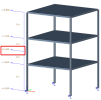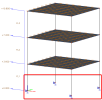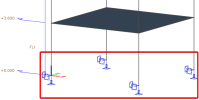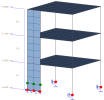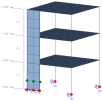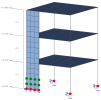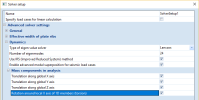IRS: Too many eigen values requested / Non-associated R-node detected
Issue
When running IRS dynamic analysis, the calculation fails with the error message:
IRS modal reduction: Detect of nonassociated r-node
or
IRS modal reduction: More then computed eigen values are demand
Meaning
During the generation of the IRS analysis model, the solver detected one or more degree of freedom of some reduction point (R-node) without any mass associated to it. It means that all the nodes of the original finite element mesh that are linked to that R-node have a zero mass value for the component corresponding to that degree of freedom.
Solution
This can happen in several cases. The solution depends on the root cause.
Bad definition of storeys
The storeys are defined in such a way, that there is no available mesh node at the level of some storey.
Each node of the finite element mesh is assigned to the closest R-node, i.e. to the closest storey level. In both examples shown above, the highlighted level has no mesh node assigned to it, because for any mesh node, there is another level that is closer.
Solution: remove useless storeys
No moveable node is associated to a R-node
This typically happens at foundation level, where all nodes are fully blocked by a support. If the finite element mesh is not refined, all the nodes that are associated to the bottom R-node are fully blocked and are removed from the analysis model, leading again to a R_node without any associated mesh node,
Solution: refine the mesh, if possible only on the members of the bottom storey.
Dividing the columns in two parts, thus inserting just one mesh node at mid-height, might not be sufficient, as the mid-node might be assigned either to the storey above or below it, depending on numerical sensitivity. To be safe, use a subdivision of at least 3.
Having partially blocked supports could also lead to a similar situation. For instance, if all supports have a flexible vertical component, but all horizontal degrees of freedom blocked, the horizontal mass components will remain non-associated. The solution is also the same.
Insufficient rotational inertia of associated nodes on 2D members
In some cases, usually quite simple models, it is possible that some rotational component of the reduced mass matrix is zero. This can happen, for instance, when all movable mesh nodes of the bottom level are on a single line (see green nodes in pictures below).
Solution:most of the time, refining the mesh of 2D members at the bottom level will solve the issue, by including a 2nd row of mesh nodes, thus ensuring a rotation inertia of the group of nodes.
Insufficient rotational inertia of associated nodes on 1D members
By default, SCIA Engineer ignores the rotational inertia of 1D members around their axis. The reason for that is, that that mass component is most of the time useless in 3D systems, as the rotational inertia components of the system are mostly due to the lever arm between the nodal masses of the structure. There are, however, structures where that torsional behaviour is a significant of the dynamic behaviour.
In the simple example above, although the mesh of 1D members is sufficiently refined, the IRS analysis fails, because of the total absence of rotational inertia of all column members.
Solution: enable the Rotation around local X axis of 1D members option in the solver setup.
Numerical singularity and numerical divergence
When some mass component is zero in the resolution for eigen values, the analysis normally fails because of a division by zero during the process. This is typically what happens when the solver returns a message about a non-associated R-node.
In some cases, however, the solver attempts to provide a meaningful solution by replacing zero components with very small values. In the case of dynamic modal analysis, this allows to obtain reliable results for load frequencies. On the other hand, it usually generates very high frequency, irrelevant modes. Those can simply be ignored.
In such a case, preferably reduce the requested number of modes to avoid irrelevant modes.


